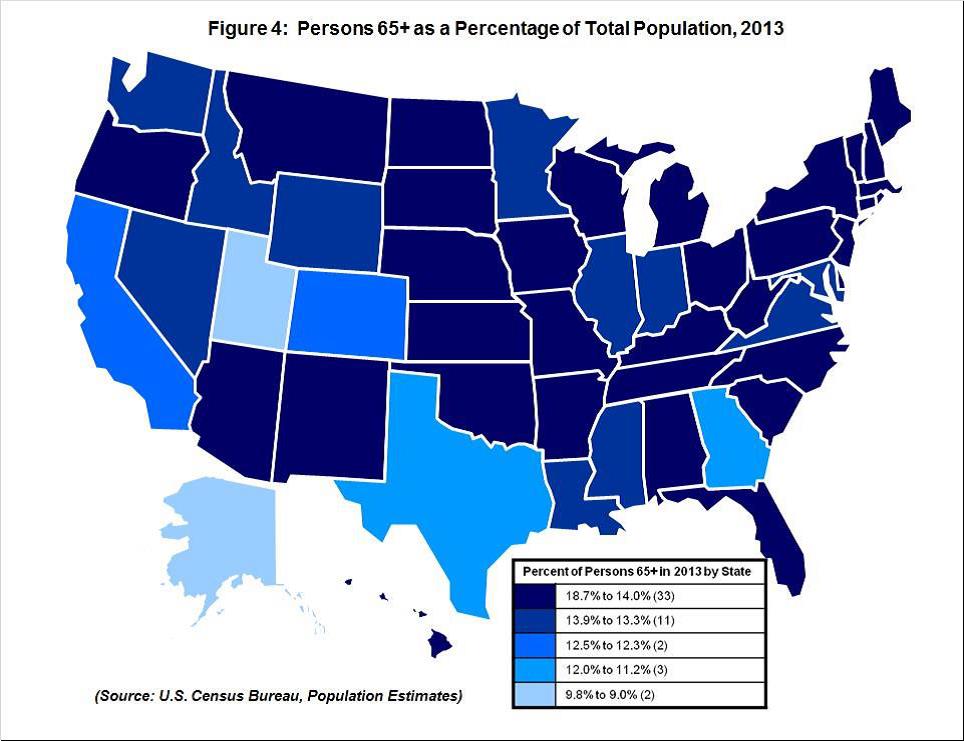Old people–specifically Americans aged 65 and older–now make up 14 percent of the population in the United States. The percentage of the population varies by state (see map below).
 There are 44.7 million of us. There are more women (25.1 million) than men (19.6 million). The population of old people in the US is expected to climb to 82 million by 2040, when old people will make up 20 percent of the total population.
There are 44.7 million of us. There are more women (25.1 million) than men (19.6 million). The population of old people in the US is expected to climb to 82 million by 2040, when old people will make up 20 percent of the total population.
In 2013, 7.5 percent of old people were of Hispanic origin, 3.9 percent were Asian or Pacific Islander, and 8.6 percent were non-Hispanic African-Americans. Altogether, 21.2 percent of old people were members of racial or ethnic minority populations.
The prospect of living in an institution, such as a nursing home, is surprisingly low. Only 3.4 percent of old people live in an institutional setting. The percentage increases as people age, but still amounts to only 10 percent of people over 85.
There were 26.8 million households headed by old people in 2013, and 81 percent were homeowners. Sixty-five percent of the old people who were homeowners owned their homes free and clear.
Most old people have completed high school (84 percent) and 26 percent have a bachelor’s degree or higher. In 2013, male old people had a median income of $29,327 and females had a median income of $16,301. In households headed by old people, the median household income was $51,486.
Some 8.4 million old people are participating in the labor force (working or actively looking for work). Old people represent 5 percdnt of the total US labor force. Thirty-seven percent of male old people aged 65 to 69–and 27 percent of the females in that age group–are participating in the labor force. Many of the old people who are not participating in the labor force are retired (but not all non-participants are retirees).
More than 4.2 million old people were living below the federal poverty level in 2013, and another 2.5 million were among the “near poor,” with incomes between the poverty level and 125 percent of the poverty level.
Most old people have a chronic medical condition. The most common medical conditions afflicting old people are arthritis, heart disease, cancer, diabetes and hypertension. About 29 percent of old people are obese. In 2013, old people had out-of-pocket medical expenses averaging $5,069 per year, or more than 12 percent of their annual spending budget.
People who reach the age of 65 have an average life expectancy of an additional 19 years. In 2010, the population of old people aged 85 and older reached 5.5 million. The population aged 85 and older is projected to grow to 19 million by 2050.
The statistics in this post are taken from “A Profile of Older Americans: 2014,” a report from the U.S. Department of Health and Human Services, Administration on Aging, and from “Older Americans 2012: Key Indicators of Well-Being,” a report by the Federal Interagency Forum on Aging-Related Statistics.
Views: 106
Some other stuff for later,
- 83Getting more exercise and not smoking may increase your lifespan, but it may be that having positive perceptions of aging is more important to longevity. According to research by Becca Levy, an associate professor of epidemiology and psychology at Yale University, people who hold positive perceptions about growing older lived…
- 57I recently visited the website of the Center on Aging Studies Without Walls at the University of Missouri—Kansas City. Within the website, there is a section that discusses the concept of “successful aging.” It has not escaped my notice that I am aging. Aging being what it is, I have…
- 50The concept of “successful aging” haunts me of late. Maybe it is just that I have time to think about aging now that I have achieved retiree status. Maybe while I continue getting older and older I wonder whether I am getting as much out of life as I should.…
Leave a Reply